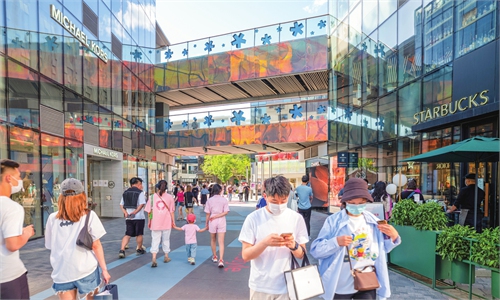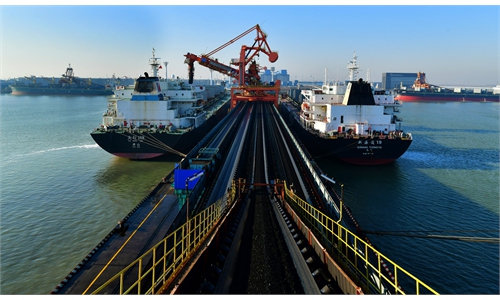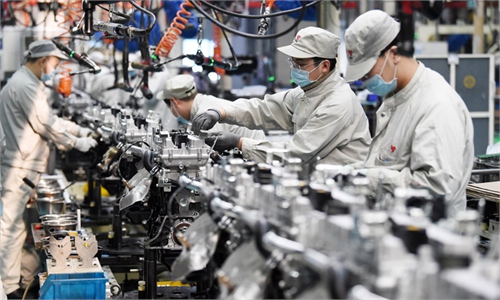V-shaped rebound expected within Q2 as China fires policy salvos to stabilize growth
More targeted approach to stop COVID-19 spread cited as underpinning economic recovery

A concept photo of digital economy Photo: VCG
With a handful of indicators that have already been unveiled pointing to a brighter-than-expected economic landscape for May, the market is eagerly anticipating other major economic data that are to be announced on Wednesday at a press conference in Beijing.
The imminent data announcement comes after a slew of central government meetings since late April that have been troubleshooting a grim economic picture throughout April when the Omicron resurgence slammed the financial hub of Shanghai.
As the reiteration of the official call for effective policy implementation plays its part in revving up the economy's rebooting, alongside an unwavering commitment to the dynamic zero-COVID policy, the economy is set for a V-shaped rebound within the three months ending June, economists said. The May data spectrum may be divergent with consumption, among other figures continuing a downtrend, they continued.
A more targeted approach to containing the COVID-19 spread, as evidenced by the ongoing efforts in Beijing, is seen as offering a dose of reassurance for the economy's continued recovery despite virus flare-ups.
Early signs
After a broad-based slump in economic activity spanning social retail sales, exports and industrial output in April, the economy was shown to have fared much better than expected over May, with figures measuring manufacturing activity, goods trade and credit growth indicating strong economic resilience.
New yuan loans picked up to 1.89 trillion yuan ($280.65 billion) in May, an increase of 392 billion yuan on the year before, central bank data showed on Friday.
Social financing, a broad measure of credit and liquidity in the economy, soared to 2.79 trillion yuan in May, 839.9 billion yuan higher than the prior year. Both numbers beat previous market estimates by a large margin.
"The recovery in May credit data reflected improving credit demand as activities have gradually resumed, as well as banks' proactive insurance of short-term credit," Wang Tao, chief China economist at UBS, wrote in a note sent to the Global Times.
The uptrend in May credit growth came on the heels of a consensus-beating rally, notably in exports.
The country's exports in US dollar terms gained 16.9 percent year-on-year in May, more than double the market consensus of a jump of less than 8 percent, according to customs figures.
This compares with a 3.9 percent increase in exports over April, a sharp fall from a 14.7 percent gain for March.
The official Purchasing Managers' Index (PMI), for its part, rebounded to 49.6 in May, up 2.2 points from April, data from the National Bureau of Statistics (NBS) showed. A reading above 50 indicates expansion while a reading below 50 suggests contraction.
Out of 21 surveyed industries, the number of sectors recording a PMI reading above 50 rose to 12 in May from the previous month's nine, according to the NBS, attributing the recovery to a gradual resumption of work and production in regions most battered by the coronavirus.
Such numbers are seen as having paved the way for an anticipated data announcement at the Wednesday press conference where the NBS will take the wraps off the economy's performance report over the Omicron-disrupted month.
The monthly industrial output, urban fixed-asset investment, property development and sales, as well as numbers of social retail sales are due out Monday.
"As exports growth has outpaced estimates, investment growth wouldn't be disappointing," Tian Yun, a Beijing-based economist, told the Global Times on Monday.
A contraction in consumption may continue in May, with a double-digit fall in social retail sales, Tian forecast.
Social retail sales shrank 11.1 percent year-on-year in April, worsening from a 3.5 percent decline over March, NBS numbers indicated.
V-shaped rebound
Seconding a divergence in the economic indicators, Lian Ping, head of Zhixin Investment Research Institute, told the Global Times on Monday that the indicators gauging consumption and property investment would continue a downtrend, while infrastructure investment is expected to accelerate during May.
However, the economy is well placed to see a V-shaped rebound within the second quarter, Lian said, speaking of a conspicuous recovery in monthly economic activity beginning late May and continuing into June that reversed the course of a downward spiral for the initial part of the current quarter. He predicted an economic expansion of 0.5 percent for the second quarter.
The economy got off to a steady start with 4.8 percent GDP growth in the first quarter, official data showed.
Buoyed by the May data robustness, Tian revised his forecast for the second quarter to over 1 percent from the previous 0-0.2 percent range.
The Beijing-based economist put first-half GDP growth at around 3 percent.
The brisker-than-anticipated economic activity is indicative of a proactive response to a raft of central government meetings since late April.
May's strong credit data is one example. "Banks have aggressively offered short-term credit following the government's call to boost credit growth. Some pent-up credit demand has been released amid gradual relaxation of COVID-19 restrictions in May," said Wang Tao of the UBS.
As of Monday, the State Council, the country's cabinet, had convened six executive meetings since April 27, primarily focusing on stabilizing growth, market entities and ensuring employment.
Beyond that, the central government has tapped into many more opportunities to address the stability push.
On May 25, the State Council held the keenly watched national teleconference on stabilizing the economy with reportedly upward of 100,000 participants, demonstrating the government's unparalleled resolve to bolster conditions as performance of the world's second-largest economy seems grimmer than expected.
On May 18, a symposium on stabilizing growth and ensuring employment was held in Southwest China's Yunnan Province, presided over by Premier Li Keqiang.
Li called for an accelerated pace and ramped-up efforts in the implementation of macro policies to stabilize the growth of market entities and shore up employment and people's basic livelihoods. Government officials from 12 provinces also attended the symposium.
In addition to that, the Political Bureau of the Communist Party of China (CPC) Central Committee held a meeting in late April to study and analyze current economic circumstances and related work.
The CPC leadership made it clear that the country must contain the epidemic, stabilize the economy and keep development secure, according to the meeting.
All these momentous gatherings send a clear signal that a coordinated approach to virus containment and economic stabilization will continue, with all the policy measures having been rolled out being effectively implemented by governments at varying levels so as to ensure steady growth regardless of both internal and external challenges, economists stressed.
What's particularly noteworthy is the more targeted approach to preventing and controlling COVID-19 that would minimize the cost of virus containment on economic recovery, Lian remarked, citing ongoing efforts to fight the virus resurgence in Beijing.
As the capital city races to cut the spread of the latest outbreak originating from a bar in Sanlitun, a major entertainment area in Beijing's Chaoyang district, it has put specific community buildings and malls, among other designated risky areas, into lockdown.
Amid the antivirus efforts over May, the city closed off multiple residential compounds, malls and office buildings in certain areas considered high-risk.
This illustrates an upgrade in the country's virus containment efforts, Lian commented.
In a bylined article published by Beijing Daily on Monday, Justin Lin Yifu, former chief economist at World Bank, wrote that China should fight the virus in a scientific way, which means avoiding abuse of power and a hope-as-you-go practice while implementing the zero-COVID policy.



